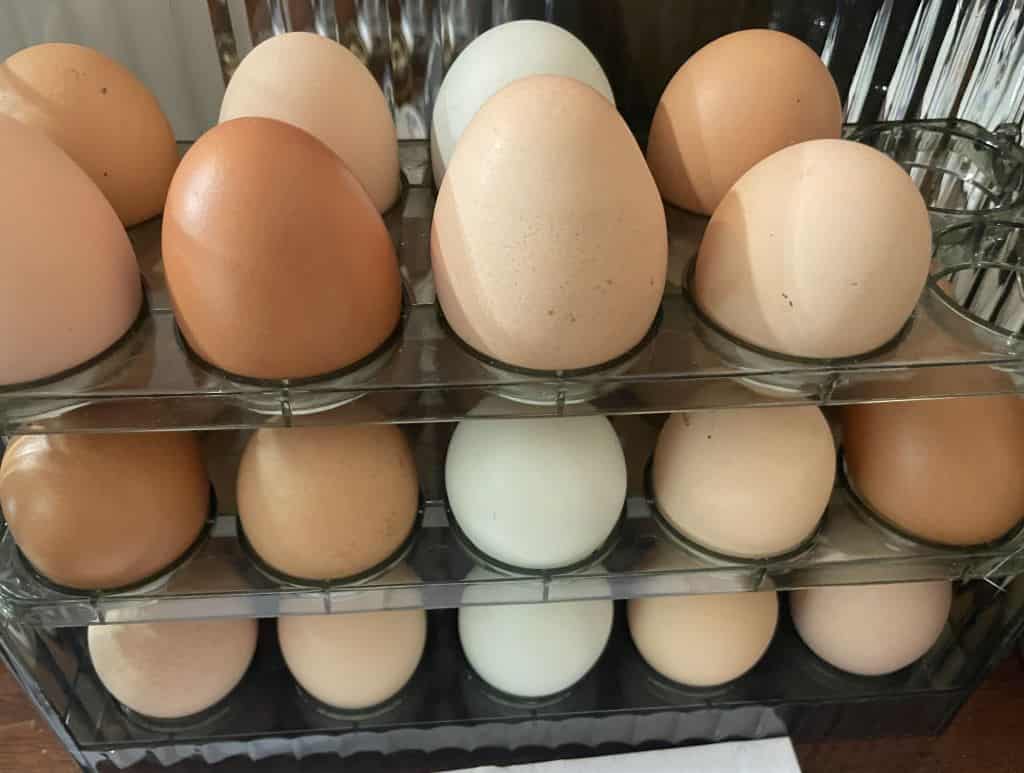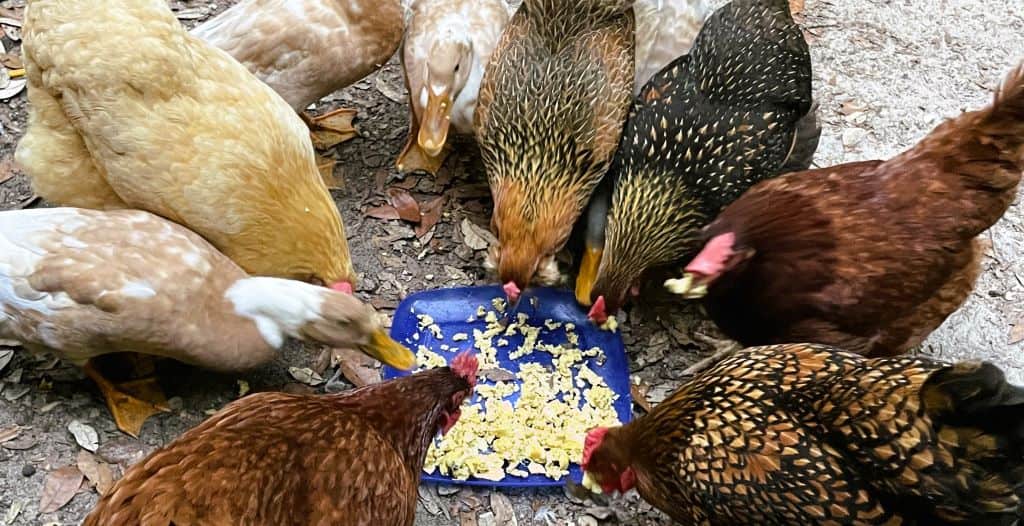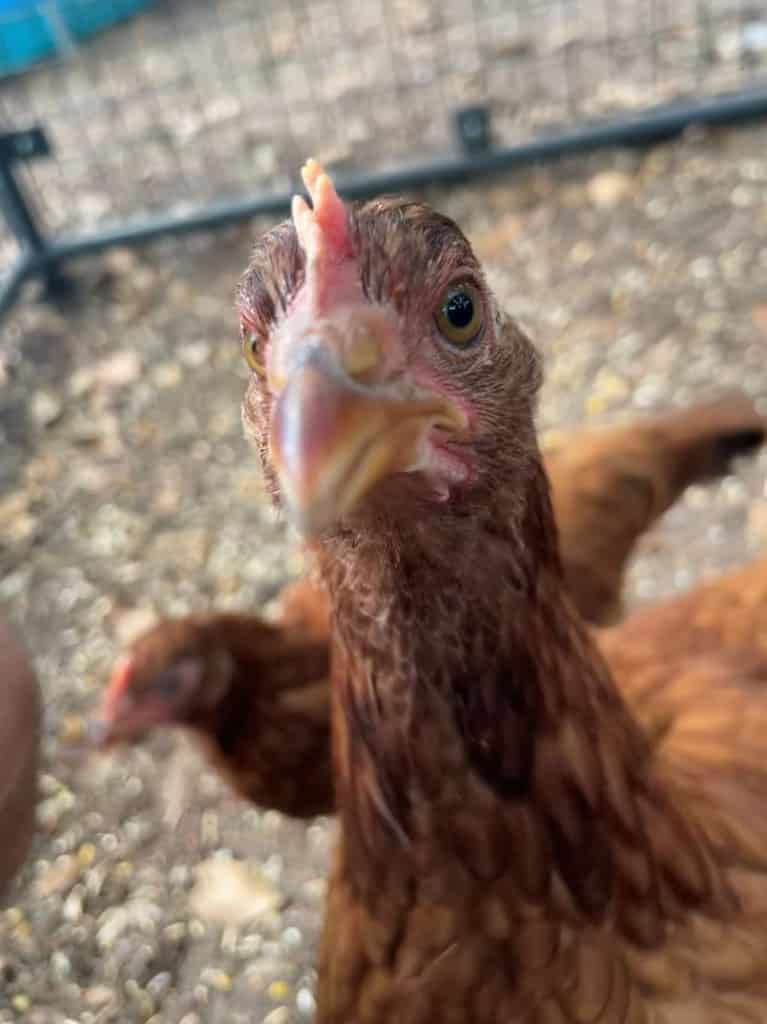While chickens are low-maintenance poultry animals (for the most part) the types of feed chickens need aren’t quite as simple. Then there are the uncomfortable rumors that spread, such as the Producer’s Pride feed (varying types) halting chicken egg production due to conspiratorial accusations of protein and proper nutrient reduction.
It’s enough to make a backyard chicken farmer’s head whirl. Outside of interesting and sometimes worrying rumors, there’s a lot that goes into feeding your chickens. At each stage of their development, their bodies need certain nutrients. That’s the reason there are so many types of chicken feed.
From their very first starter feed meal to organic and medicated feed, we’ll cover all the types of feed chickens need so you don’t end up blindsided, dealing with illness or a lack of egg production. A happy chicken lays the best eggs after all!
Starting with Starter Feed

©
This is one of the most obvious types of feed chickens need. They have to start on something and starter feed is designed to meet their nutritional needs. This includes extra protein. Chickens grow fast and the added protein and calcium in starter feed fuels their muscle and bone growth. Pure starter feeds are only good for the first 6 weeks of life.
Starter feed contains about 20% to 25% protein, more than enough for a rapidly growing chicken. It’s too much after 6 weeks since it can cause organ damage if you continue.
Starter/Grower
New chicken owners might confuse this for starter feed. It is, to a degree. however, it has a broader range than standard starter feed and is fine for chickens up to 20 or so weeks of age. The best way to tell the difference between starter/grower and starter feed is to read the ingredients label on the back.
Grower Feed
Introduce this food to your new flock after the 6-week mark. It’s not as protein-intensive as the starter feed and usually contains about 16%, but no higher than 18%. At this stage, you’re thinking in terms of teenagers, otherwise known as pullets. At this point, you’ll notice your chickens are faster, and more reactive to your presence, and some will develop small, visible feathers.
Grower feed also lacks the higher calcium amounts found in starter and starter/grower. It’s important to remember that all chicken breeds are a little different, some drastically so, and will lay their first eggs at differing dates. If you have multiple types of chickens, things may get a little dicey. The types of feed chickens need are different for laying and growing.
Layer Feed for Laying Time

Plastic shelf stack for fresh-laid chicken eggs.
©
Though the introduction of layer feed is often given a generic timeframe of 16 weeks, not all breeds will start laying that soon. Some won’t lay well into the 30s in terms of weeks. Feeding them laying feed well before they are ready.
Layer feed returns the chickens to a protein and calcium-rich diet. It takes a good deal of energy to lay eggs, especially if you have a breed that lays 250+ eggs per year. That energy needs consistent replenishment and that’s where layer feed benefits your flock.
Mash and Crumble
Don’t confuse crumble for adult chickens with starter crumble. The two bags will have identifying markers indicating what they are. Crumble for adult chickens is mostly layer crumbles. Layer feed includes layer crumble, layer mash, and layer pellets.
This is where the variety gets confusing and it depends on what types of feed your chickens need, a fact you determine by observing their behavior, energy, and laying ability. If you know your chicken is a 200+ egg per year producer and is only laying every three or four days, it’s probably time to switch diets.
Regardless of what chicken breeds you own, you need to know the average size of their eggs and their production levels. This is the kind of information that guides your hand in selecting the right feed. When your chicken needs more energy for laying or is just starting to lay, layer crumble or pellet with 20% protein and higher calcium is typically the best.
You also need to feed them higher protein levels when they start their first molt, which is usually around a year and a half of age. Egg production will generally drop throughout this time frame. Mash is simply another version of some of the above feeds and chickens tend to love it. It stands atop the chicken feed field because chickens will likely go after it over everything else.
Plus, the mash is a good replacement in the winter if you prepare it by mixing in warm water. It makes a sort of slop but your chickens will devour it. Unfortunately, it’s also quite messy and doesn’t last long in the summer before it starts growing moldy.
Scratch Grain
Scratch grain is sort of a jack of all trades master of none. It’s more of a treat than an actual nutrition-directed feeding regimen. It won’t provide the levels of protein necessary for a laying flock and it’s no good for developing chicks. One thing that scratch grain does well is fuel your chicken’s energy supply.
This makes it a good choice for mixing in with laying feed during the winter. It will keep their energy up, and their bodies warmer, and will help push egg production during a time of the year when chickens slow down.
Table Scraps

As long as they don’t realize they’re eating eggs, chickens won’t learn to destroy their own.
©
Writers across the web will try to warn you away from feeding chickens your table scraps. However, they always seem to miss the point. It’s perfectly fine to feed your chickens chicken scraps so long as you do it the right way and don’t overdo it.
First, you don’t want to feed the chickens table scraps early in the day. This is because they will fill up on table scraps, ignoring their food which has the nutritional value they need. In other words, make them eat their breakfast, lunch, and dinner before you give them dessert.
Second, don’t give them unhealthy food just because you don’t want to eat it. While the occasional fatty food is okay, it needs to be very occasional. The types of feed chickens need to correlate with several table scraps that simply make sense. And, your chickens will love it! These include the following:
- Fruits and veggies (cooked, raw, or frozen)
- Cooked meat
- Cooked beans
- Eggs but never as a whole, boiled egg (you don’t want them to recognize it as an egg)
- Grains
- A variety of cooked seafood
If you feed your chickens whole, boiled eggs, they will eat them. Then, they’ll think the eggs they lay are the same as those delicious boiled eggs and will attack their eggs. Scraps with high protein and calcium are perfect for laying hens, so consider those when you do feed them from the table.
Fermenting Chicken Feed
This is a process, rather than a product. Fermenting your chicken feed retains all of its nutrition while adding to it as well. This includes riboflavin, folic acids, and thiamine, all of which directly impact your flock’s health in positive ways.
Also, since it’s a denser form of feed, your chickens need less of it, saving you on overall feed costs without sacrificing nutritional value daily.
Shell and/or Oyster Grit
The types of feed chickens need often require a supplement. In this case, it’s a boost in calcium intake with a dash of digestion improvement. Chickens need to store a portion of grit in their gizzards because they lack the teeth necessary for pulverizing food. They essentially use this stored grit as a set of teeth. It’s odd but it works.
Plus, if you notice your hen’s eggs aren’t exactly shaped right, they’re probably lacking in calcium. Mixing a little shell or oyster shell grit in with their regular feed will fix this in short order.
Chicken Treats

Chickens get excited when they know it’s treat time.
©
Besides scratch grains and leftover scraps from the kitchen table, there are also specifically formulated treats available for chickens. There are several scratch grain types to choose from, not just the standard bags you see in feed and seeds. These bags are typically much smaller. You can also feed them blocks/bricks of scratch grains.
However, you may have to fend off the squirrels so your chickens can truly enjoy them. Chickens also love mealworms. One good way to create a perpetually supplying treat source is to build earthworm farms in your backyard. Another way is to buy them mealworms, dead or alive.
If you want to feed them a nice summer treat, place a handful of vegetables in each cup on a cupcake pan. Fill it with water and let it freeze in the freezer. It’ll make a veggie-packed popsicle for the chickens throughout the summer months and is very inexpensive to make.
Treats, like leftovers, are just that, however, and shouldn’t be given constantly.
Medicated Feed
Medicated chicken feed is generally a starter feed product, manufactured for chicks who are susceptible to coccidiosis, which comes from the feces of other chickens. It’s hard to say how chickens are handled from the source, through the mail, to the retail chain, and beyond before you purchase them.
They may have been exposed at some point and it’s up to you if you want to buy medicated starter feed assuming you purchase the chicks when they’re young enough to need it (typically 1 to 4 weeks of age). If you’re purchasing chicks from a private seller, you may be fine depending on the reputation of the seller.
Final Thoughts on Types of Feed for Chickens
That covers everything in terms of what your chickens may need throughout their life cycle. Older hens can revert to pullet or grower feed when they are no longer laying but there’s no additional feed type for old hens.
All of the above will more than take care of your chicken’s needs and, more importantly, keep them happy and laying regularly according to their breed’s capacity to produce. Some produce way more than others and some chickens are almost entirely for show, laying very little throughout the year (silkies).
For your premium layers, just keep the calcium and protein rolling in and you’ll be fine in most cases. If you take the time to ferment it, so much the better.
The photo featured at the top of this post is © Olesya Andreeva/ via Getty Images
Thank you for reading! Have some feedback for us? Contact the AZ Animals editorial team.







